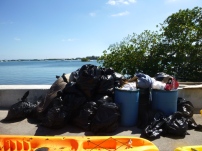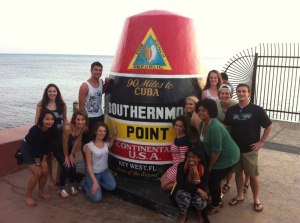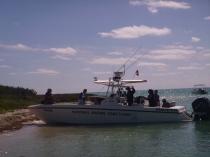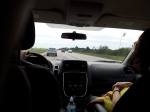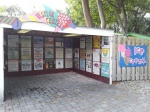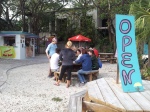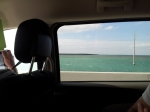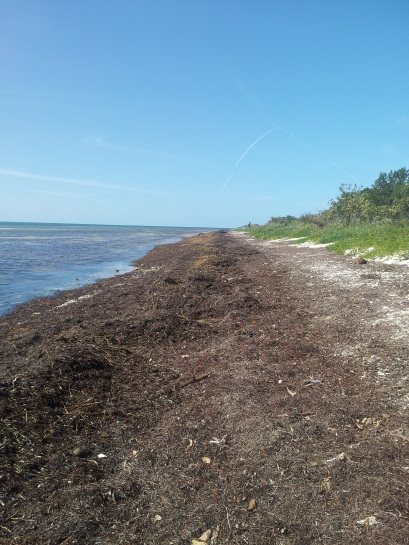
Geiger Key Beach
I am dreaming of a land where the sun, so bright and strong, claims its unknowing and beachgoing victims with bright-red marks and scorching burns that can only be quelched with time and glops of aloe.
I am dreaming of a land where the circulating air within a car carrying a gaggle of bikini-clad and sunglasses-wearing college students reeks of Hawaiian Tropic sun lotion with notes of coconut and a hint of flowers.
I am dreaming of a land where the shapes and colors of its contemporary-island-styled houses on a single block vary from shell spiral to flamingo pink; cobblestone to sun-bleached white; a block filled with tourists and locals alike, dotting the roads with two-wheelers, golf carts, and sedans with conch shells decorating the dashboard.
I am dreaming of a land where other dreamers including Ernest Hemingway and Tennessee Williams have dreamed and where active citizens have, once in their history, retaliated with all their heart for the Conch Republic.
I am dreaming, but my dream was alive during my spring break of 2013.
Through the University of Florida’s Florida Alternative Breaks (FAB) trip to Key West, Fla., from March 2-9, I had some of the most amazing opportunities. But while I got to meet passionate students and fun-loving locals and participate in marine-life activities, I sensed a constant paradox between my Key West experience as a tourist with my FAB marine-life experience as an environmental activist. Though the Key West tourism industry stimulates jobs and economy, the tourism impacts the beauty of its natural environment through the beer cans and other trash that I had witnessed piled within the sea-lining sludge.
During an education segment at the Florida Keys Eco-Discovery Center, I was shocked by an image depicting how microplastics outweigh plankton at the ocean’s surface by a six-to-one ratio. Having learned about the non-degradability of plastics and its endocrine-disrupting compounds (EDCs) from my school’s environmental class, this visual disturbed me most.
Ninety percent of marine debris are plastics, which do not degrade and only deteriorate into smaller and smaller pieces, increasing the chances of them being ingested by marine animals. Additionally, of all the animals affected by the sea debris, sea turtles make up 80% of this affected population.
Though our group had spent the week cleaning up beach shores, the impact of what we were doing really hit home on one particular day.
It was a Wednesday afternoon and the sun shown brightly and cool breeze blew. Our group with two Florida Keys National Marine Sanctuary staffers were cleaning the Geiger Key Beach shoreline, which was littered with plastics. While cleaning, two pre-veterinary students went to collect what appeared to be a lump of garbage bobbing far out among the sea currents. This lump actuallly turned out to be a loggerhead sea turtle swimming in circles on its side, seemingly helpless and in danger.
The pre-vet students diagnosed a problem with the turtle’s buoyancy and attributed it the turtle’s swim bladder having possibly popped, or perhaps the turtle had eaten something that was putting it off-balance. Given that the injured turtle was found near this littered beach, I couldn’t help but put two and two together.
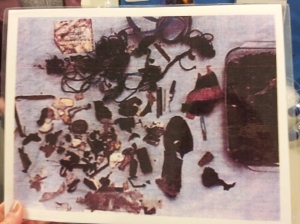
Man-made items found within a turtle’s stomach
Later on, and while venturing to clean a more littered part of the beach as the sea turtle was carried away on the turtle hospital ambulance, our group once again stumbled upon a smaller turtle that was both washed ashore and far from saving.
This experience has shown me how one can help Key West’s natural environment at the most direct level, but I feel that my place lies at impacting the environment from a public policy perspective. I feel that if laws were made and enforced to reduce the pollutants resulting from Key West tourism, as well as pollutants washing ashore from other nearby places, these marine creatures would not die a plastic death.
According to Reef Relief Executive Director Mill McCleary, what flows out from the Keys goes directly into the ocean. There are 972 storm drains in Key West, and everything that flows down the drains bypasses the water treatment plant and goes directly into the ocean.
‘If you just sit on Duval Street and watch people, you’ll literally see thousands of cigarette butts being thrown down the storm drains,’ McCleary said.
With about 18,000 Key West locals and over three million visitors a year, raising awareness and creating policies to reduce marine debris are greatly needed.


 The other things I will remember will be the opportunities that I’ve had to remove almost 2,000 pounds of trash from the Key West environment (namely its shorelines and mangroves in the line of sea currents bringing debris from places including Central America), the ability to ride a skiff zooming through the sea, passing surfacing turtles and dolphins, and the chance to venture through remote islands, including Woman Key, and hotspots frequented only by locals. Though our trip was brief and only half of my Key West bucket-list items were checked off, I guess it looks like I’ll just have to come back again, relatively soon…
The other things I will remember will be the opportunities that I’ve had to remove almost 2,000 pounds of trash from the Key West environment (namely its shorelines and mangroves in the line of sea currents bringing debris from places including Central America), the ability to ride a skiff zooming through the sea, passing surfacing turtles and dolphins, and the chance to venture through remote islands, including Woman Key, and hotspots frequented only by locals. Though our trip was brief and only half of my Key West bucket-list items were checked off, I guess it looks like I’ll just have to come back again, relatively soon…
